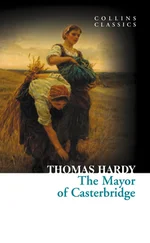CONTENTS
Cover
Title Page
History of Collins
Life & Times
Chapter 1
Chapter 2
Chapter 3
Chapter 4
Chapter 5
Chapter 6
Chapter 7
Chapter 8
Chapter 9
Chapter 10
Chapter 11
Chapter 12
Chapter 13
Chapter 14
Chapter 15
Chapter 16
Chapter 17
Chapter 18
Chapter 19
Chapter 20
Chapter 21
Chapter 22
Chapter 23
Chapter 24
Chapter 25
Chapter 26
Chapter 27
Chapter 28
Chapter 29
Chapter 30
Chapter 31
Chapter 32
Chapter 33
Chapter 34
Chapter 35
Chapter 36
Chapter 37
Chapter 38
Chapter 39
Chapter 40
Chapter 41
Chapter 42
Chapter 43
Chapter 44
Chapter 45
Chapter 46
Chapter 47
Chapter 48
Classic Literature: Words and Phrases adapted from the Collins English Dictionary
Copyright
About the Publisher
In 1819, millworker William Collins from Glasgow, Scotland, set up a company for printing and publishing pamphlets, sermons, hymn books, and prayer books. That company was Collins and was to mark the birth of HarperCollins Publishers as we know it today. The long tradition of Collins dictionary publishing can be traced back to the first dictionary William published in 1824, Greek and English Lexicon . Indeed, from 1840 onwards, he began to produce illustrated dictionaries and even obtained a licence to print and publish the Bible.
Soon after, William published the first Collins novel, Ready Reckoner ; however, it was the time of the Long Depression, where harvests were poor, prices were high, potato crops had failed, and violence was erupting in Europe. As a result, many factories across the country were forced to close down and William chose to retire in 1846, partly due to the hardships he was facing.
Aged 30, William’s son, William II, took over the business. A keen humanitarian with a warm heart and a generous spirit, William II was truly “Victorian” in his outlook. He introduced new, up-to-date steam presses and published affordable editions of Shakespeare’s works and The Pilgrim’s Progress , making them available to the masses for the first time. A new demand for educational books meant that success came with the publication of travel books, scientific books, encyclopedias, and dictionaries. This demand to be educated led to the later publication of atlases, and Collins also held the monopoly on scripture writing at the time.
In the 1860s Collins began to expand and diversify and the idea of “books for the millions” was developed. Affordable editions of classical literature were published, and in 1903 Collins introduced 10 titles in their Collins Handy Illustrated Pocket Novels. These proved so popular that a few years later this had increased to an output of 50 volumes, selling nearly half a million in their year of publication. In the same year, The Everyman’s Library was also instituted, with the idea of publishing an affordable library of the most important classical works, biographies, religious and philosophical treatments, plays, poems, travel, and adventure. This series eclipsed all competition at the time, and the introduction of paperback books in the 1950s helped to open that market and marked a high point in the industry.
HarperCollins is and has always been a champion of the classics, and the current Collins Classics series follows in this tradition—publishing classical literature that is affordable and available to all. Beautifully packaged, highly collectible, and intended to be reread and enjoyed at every opportunity.
Life & Times
About the Author
Thomas Hardy was born in a Dorset village in 1840. Although he had a modest upbringing, Hardy found himself working successfully as an architect in London at the age of 22. He spent five years in London, but was eventually drawn back to Dorset because he did not enjoy the urban environment or the class prejudice he felt, mixing with the well-heeled of England’s capital city. Having returned to the countryside, he began to consider an alternative career as a novelist. By 1867, he had already completed a manuscript, but had no luck placing it with a publisher. Despite this, his ambition knew no bounds and he persevered securing his first publication in 1871. His first five novels were well received, and Hardy’s confidence in pushing the literary envelope grew steadily.
Thomas Hardy, observing that the real behaviour of people was often driven by animal instincts rather than social etiquette, used his literature to take a swipe at Victorian respectability. His stories are filled with characters who are extreme in their thoughts and actions, since he uses them as representations of the human traits that he wishes to analyze.
The Woodlanders is typical of Hardy’s literary style. The characters cannot help but make life more complicated than it needs to be, because the author ascribes them with traits that make them flawed: they are personifications of the flaws that Hardy wishes to criticize in his fellow humans. One gets the impression that Hardy finds great amusement in doing this, precisely because it becomes apparent that the very notion of respectability is an impossible ambition.
The privileged characters make a mess of their lives because they are either compelled by base desires or lack the common sense, intelligence and self-discipline to know what is right. The unprivileged characters are the victims who suffer injury brought about by their lack of leverage in society. All the while, though, the physical rural environment remains beautiful, constant and reliable, and it is the juxtaposition of the natural world and the human world that gives Hardy’s novels their essence.
His sixth novel The Return of the Native (1878) is widely regarded as the first modern novel, because it dared to examine themes that Victorian society brushed under the carpet – namely sexual desire and obsession. The central female character, Eustacia, is something of a femme fatale. She is distractingly beautiful, but her seductive manipulation of the male characters leads to her death and that of her lover Wildeve. The book caused a stir in polite society, but it raised the bar in terms of what a novel could achieve as a medium for comment on the human condition. Eustacia essentially saw herself as a special individual and her ambitions led her to behave in ways that the local community could not accept. She was vilified for her lack of ability to fit in and accept her lot in life.
In 1886 Hardy published The Mayor of Casterbridge . At a country fair, Henchard, Hardy’s tragic hero, auctions off his wife and daughter when he’s drunk. He spends most of his life repenting for this act and eventually becomes an upstanding citizen of Casterbridge. Throughout the novel, Hardy focuses on the importance of reputation and good character and demonstrates how the present is always haunted by the past and cannot be denied.
Hardy’s best-known novel, Tess of the d’Urbervilles , was published in 1891. Tess starts out as an innocent peasant girl, but embarks on a tragic tale that ends in her execution for murder. For Hardy, the story was an examination of how the individual can wind up in such desperate situations, even when their beginnings are much the same as others people’s. Like Eustacia, Tess is attractive and her ambitions lead her into scenarios that make her life ever more unsettled. The admission that people could be drawn by lust and desire to flout the rules of society came as a shock to the Victorian audience, but Hardy was also attempting to show what happens when rules are ignored. In essence, Tess is a victim of circumstance, but she is still allowed to make her own decisions. It is this interplay between the involuntary and voluntary that makes Tess’ story so tragic, and also explains why the book is regarded as a masterpiece of English prose.
Читать дальше












